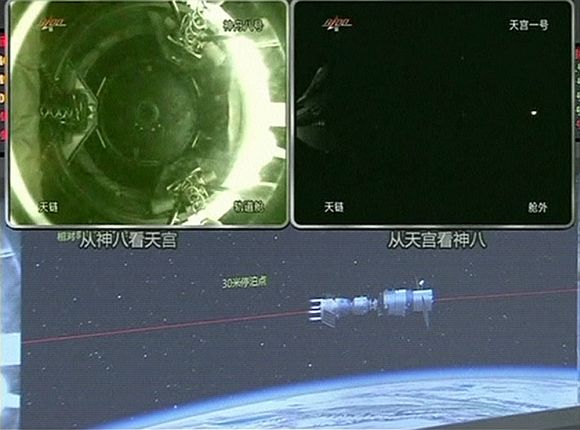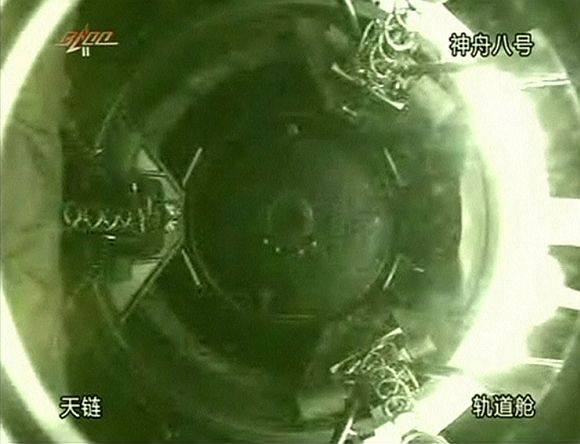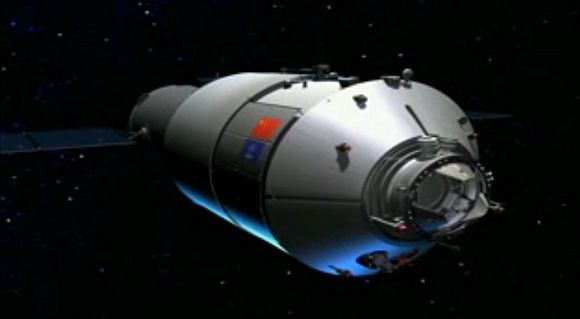Photographs: CCTV via Reuters TV
China on Thursday took a great leap forward in fulfilling its ambition to establish a manned space station by 2020 when it completed its first successful docking above the earth.
The Shenzhou 8 spacecraft silently coupled the Tiangong 1 module more than 343 km above earth, in a manoeuvre carried live on state television.
The success of the docking procedure makes China the third country in the world, after the United States and Russia, to master the technique, moving the country one step closer to establishing its own space station.
China is now equipped with the basic technology and capacity required for the construction of a space station, Zhou Jianping, chief designer of China's manned space programme said.
Click on NEXT to go further...
PHOTOS: China takes a BIG leap; accomplishes 1st space docking
Image: Tiangong (Heavenly Palace) 1 module (top L) as it docks with the Shenzhou 8 spacecraftPhotographs: CCTV via Reuters TV
"This will make it possible for China to carry out space exploration on a larger scale," he was quoted by the state run Xinhua news agency as saying.
President Hu Jintao, who is in France for the G-20 summit, sent a congratulatory message on the success of the country's first-ever space docking.
"Breakthroughs in and acquisition of space docking technologies are vital to the three-phase development strategy of our manned space program," Hu said.
"The capability increases China's ability to act independently in space, as well as its ability to cooperate with others," said Gregory Kulacki, senior analyst and China project manager at the global security programme of the Union of Concerned Scientists.
The world's first space docking was achieved in 1966, when the manned US spacecraft Gemini 8 docked with an unmanned Agena Target Vehicle.
Click on NEXT to go further...
PHOTOS: China takes a BIG leap; accomplishes 1st space docking
Image: A monitoring screen at the Beijing Aerospace Flight Control Centre shows China's Tiangong (Heavenly Palace) 1 module as seen from the Shenzhou 8 spacecraft after dockingPhotographs: CCTV via Reuters TV
Currently Mir space station is operated by Russia and United States. China's proposed station is smaller than that.
"To link up two vehicles travelling at 7.8 km per second in orbit, with a margin of error of no more than 20 centimetres, is like 'finding a needle in a haystack'," Zhou Jianping said.
The Shenzhou-8 and Tiangong-1 will separate after flying together for 12 days. After that a second docking procedure will be conducted.
Without this key know-how, exploration of the moon and beyond requires carrier rockets with significant amounts of thrust.
China does not currently possess rockets of this magnitude, he said.
The interior of both the Shenzhou-8 and Tiangong-1 is an actual environment in which astronauts can live and work.
Click on NEXT to go further...
PHOTOS: China takes a BIG leap; accomplishes 1st space docking
Image: This artist's illustration from a China space agency video shows the Tiangong 1 space laboratory, a prototype module for the country's planned space stationPhotographs: China Manned Space Engineering Office
After the Shenzhou-8 tests, the Tiangong-1 will remain a target orbiter for more docking procedures in 2012 by the Shenzhou-9 and -10 spacecraft, at least one of which will be manned to conduct manual docking.
Two female astronauts are now believed to be on the active duty roster for future Shenzhou missions, said Chen Shanguang, director of the Astronaut Centre of China
"We must assess both male and female astronauts to verify if human beings can live in space, as there are huge differences between men and women in spite of their common generalities," Chen said.
"Space exploration activities would be incomplete without the participation of female astronauts," Chen said.
The Chinese spacecraft also feature collaborative space experiments under the framework of a Chinese-German science and technology cooperation.
German scientists designed bio-incubators for the experiments, while their Chinese counterparts were in charge of the development of control equipment, China's manned space programme spokeswoman Wu Ping said.
Click on MORE to see another feature...





article